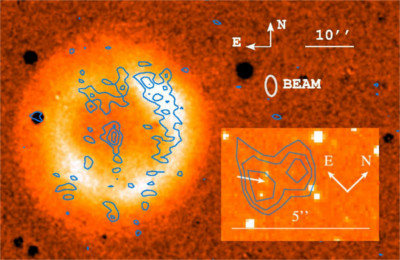MolPlan: New cradles of molecules in interstellar space: planetary nebulæ
When low- to middleweight stars like our Sun approach the end of their lives, they first become red giants and eventually small white dwarf stars. In doing so, the old giants cast off their outer layers of gas and dust into space, creating beautiful planetary nebulae (PNe). During the PN stage the remaining stellar core is a hot white dwarf, whose intense UV radiation should destroy most molecules that had previously been ejected, and hamper the formation of new molecules in the nebula. In recent years however, it has become clear that the molecular content of PNe is not as sparse as originally thought. The 2014 detection of OH+ in the Helix nebula with the Herschel satellite was the first clear evidence for the formation of molecular ions in PNe. This has created many scientific questions regarding the survival and formation of molecules in PNe. From observations we know that the molecules reside in or near dense clumps where they are shielded from the UV radiation of the central star. It is in such clumps that molecules may survive the PN phase and new molecules may be formed. Such clumps are observed in a number of highly evolved PNe with central stars where the nuclear burning has stopped and the luminosity of the central star has dropped significantly. The origin of these clumps is heavily debated. Many scientists argue that they are remnants of an early phase of the evolution before the central star started ionizing the nebula. However, such clumps are not identifiable in young PNe. This seems contradictory. Hence we propose to quantitatively investigate a new physical instability which may lead to the formation of clumps in recombining ionized gas around cooling white dwarfs. We will use the PDR code Cloudy to derive the temporal evolution of the physical conditions in a recombing plasma. This model will then be used in a theoretical analysis to determine if the gas is unstable in the way we proposed and what the time scale would be to form the globules. Finally, we will use Cloudy to create a model of the advection flow off the globules in the Helix nebula by matching it to the Herschel spectrum.
 A dying star, the Helix planetary nebula, is throwing a cosmic tantrum in this combined image from NASA's Spitzer Space Telescope and the Galaxy Evolution Explorer (GALEX). Image credit: NASA/JPL-Caltec
A dying star, the Helix planetary nebula, is throwing a cosmic tantrum in this combined image from NASA's Spitzer Space Telescope and the Galaxy Evolution Explorer (GALEX). Image credit: NASA/JPL-Caltec
Sakurai's object underwent a very late thermal pulse (VLTP) in the early 90's, then quickly cooled down to a born-again Asymtotic Giant Branch (AGB) star and recently started reheating. It will eventually form a new PN inside the old one. During the VLTP, the central star ingested the remaining hydrogen of its envelope into the helium burning layer leading to a hydrogen-ingestion flash. This created a unique set of physical conditions leading to the so-called i-process for creating heavier elements, which is intermediate to the well known s-process working in AGB stars and the r-process active in supernovae. The i-process is important in the first generation of stars and was proposed to occur in Sakurai's object by F. Herwig, but still needs to be corroborated by observations. After the hydrogen-ingestion flash, the processed material is immediately ejected into space and is currently forming molecules and dust. This creates a unique opportunity to study the i-process and molecular chemistry in a carbon-rich environment in real time.
 Image of the old planetary nebula around Sakurai's star with the radio contours from the 2004 Very Large Array observations superimposed (Hajduk, M., Zijlstra, A. A., Herwig, F., van Hoof P. A. M., et al., Science, 2005, 308, 231)
Image of the old planetary nebula around Sakurai's star with the radio contours from the 2004 Very Large Array observations superimposed (Hajduk, M., Zijlstra, A. A., Herwig, F., van Hoof P. A. M., et al., Science, 2005, 308, 231)
The origin of carbon lies in the nucleosynthesis in stars. One of the few carbon-rich environments found in space are the ejecta of AGB stars. A unique organic synthesis flourishes in the gas phase in these envelopes and a wide range of complex carbon bearing molecules are found, similar to organic molecules found in dense clouds, from which stars and planetary systems originate. AGB stars evolve into PNe. What becomes of the molecular material from the AGB shell once the nebula is ionized by the strong ultraviolet radiation emitted by the white dwarf? Which molecules survive, which are formed, and how, are important questions, which need to be answered in the quest to understand the chemical enrichment of dense clouds from which stars and planets originate. The understanding of the i-process is important for the understanding of the evolution of the first generation of stars and hence for cosmology. Our proposed research will provide critical constraints for modelling this process.